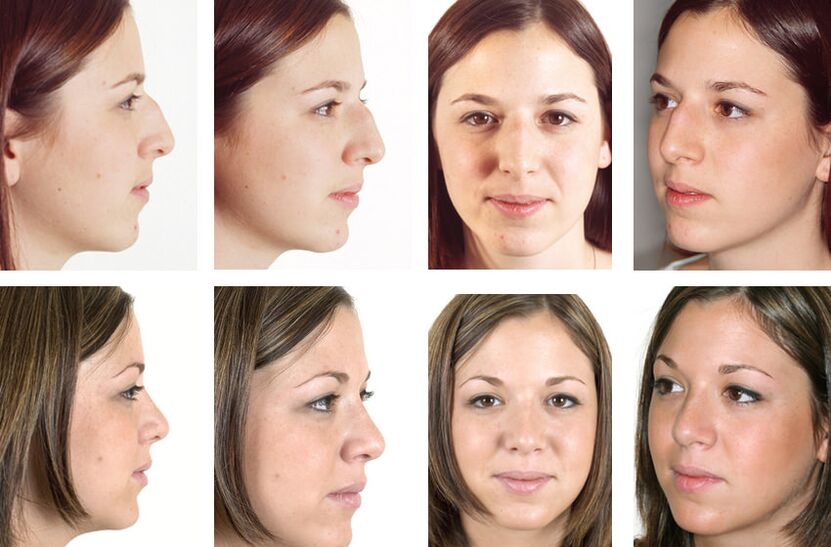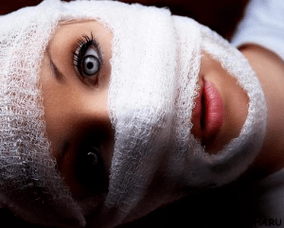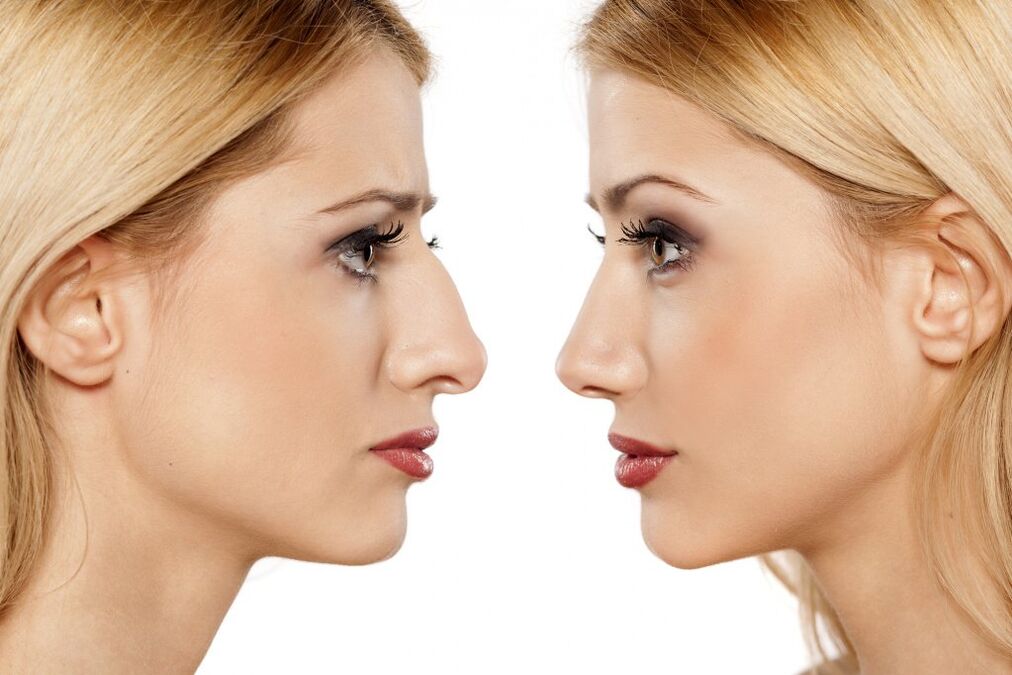Rinoplasty is a special surgical operation to repair congenital or acquired nasal defects and to increase the lack of nose.
The nose plastic operation lies in the surgeon changes the nasal parameters with the invasion of the nasal bone chryashny frame.
The main task of such an operation is to return the proper shape of the nose to a person who has been violated before birth due to illness or nasal damage.
Types of nose sculpture
Nowadays, the world uses this type of rinoplasty of the nose:
- septoplasty;
- closed nose sculpture;
- Open nose sculpture;
- nasal plasticity in secondary behavior;
- nose plastic without surgery;
- Nasal plastic when using fillers;
- nasal plastic using special supplemental drugs;
- Rinoplasty with aptos fibers.
Septoplasty
Septoplasty is a surgical intervention that determines the elimination of nasal septum errors - cartilage and bone displacement that interferes with normal functions and aesthetic type of nose.
Indications of people's septoplasty:
- Constant nose congestion for no obvious reason;
- snoring;
- nasal development errors or nose partitions;
- permanent or periodic nose bleeding;
- the presence of chronic sinusitis;
- general deformation of the nose;
- The result of nose injury that prevents normal breathing function.
Contraindication of septoplasty:
- the presence of diabetes;
- too much distortions of the nasal septum;
- The presence of cardiovascular disease.
Closed nose sculpture
Closed nose plastic as surgery can be tolerated by a patient more easily than open nose plastics. This procedure is carried out by endonal access to the nose, ie cuts are carried out directly inside the nose.
This operation has many benefits to the patient, but it is extremely uncomfortable for the surgeon, as it is easier for any surgeon to perform surgery in a well -available area of operation. Accordingly, there are many more chances of a medical defect in closed nose sculpture, which may result in complications or other problems in the patient.
Advantages of closed nose sculpture:
- The duration of the operation is much less than open nose plastic;
- The nasal tissue is not cut on the surface of the nose and smaller cuts themselves;
- The appearance of scars is less likely;
- after minor edema surgery;
- The result of the operation is visible a few days earlier.

Indications of closed nose plastic:
- aesthetics (curve, nasty nasal shape, nasal deformation, etc. );
- Medical (nasal injury, lack of breathing due to improper nasal structure).
Contraindication of these types of operations:
- the presence of mental illness in the patient;
- insufficiency in the desires of the patient's final result;
- the presence of diseases in which any nose plastic is contraindicated;
- The patient has previously performed a number of unsuccessful nasal plastic, which have greatly deformed the soft tissues of the nose.
Since closed nose plastic is a rather complex operation, the patient may have the following complications:
- inflammation of the nose;
- formation of scars (rarely);
- the formation of pigmentation on the skin that may remain forever;
- bleeding;
- nose bleeding;
- swelling or hematomas around the nose;
- Incorrect nose shape that requires a secondary operation.
Open the nose sculpture
Unlike the closed, the open nose plastic is done with a small cut with a diameter of 4-5 mm. Thanks to such a barely visible section, the skin of the nose can be completely rise and the surgeon will be much more comfortable working with the open skeleton of the nose because it sees the organ's entire external structure before, unlike closed nasal poplastics. This greatly reduces the chances of surgical error.
In addition, open nasal plastic for the primary operation is recommended as it eliminates more precisely all existing nasal defects, unlike closed nose plastic, which does not always guarantee the same result.
Rinoplasty in secondary behavior
Secondary nose sculpture is performed when the primary failed and necessary to repair the complications. This can be done open and closed.
Rinoplasty without surgery
Rinoplasty without surgery is performed only in 4-7 % of patients without surgery. With it, only smaller nasal defects can be repaired. In the structure and appearance of the nose, more serious problems require only a complete nose plastic operation.
Rinoplasty when using fillers
This procedure is performed if the patient only wants to eliminate smaller nasal errors. For example, these can be various minor disadvantages, errors, extending the nasal tip, inadequacy of symmetry, etc. In these cases, doctors use special fillers that are introduced into the nose tissue and correct the problem.
The advantage of this method is that the nasal restoration is much easier and the procedure itself is not as painful as the usual surgical intervention.
The disadvantages of nasal plastic fillers are possible changes in the structure of the nasal tissue and "migration" on the nasal surface of the drug.
Nasal Plastics Using Special Supplemental Medicines
Surgeons use special drugs to perform such a procedure, based on hormones that are introduced into defective nose zones.
The advantage of such nose plastic is that the patient is not exposed to surgical intervention. However, the major disadvantage of such nose plastic is that by improperly calculating the dose of the drug and introducing it, the patient may have various complications and deterioration of errors.

Nose sculpture with fibers
This procedure is carried out with fibers that doctors pull their nose and nasal stalks. These fibers stand through the special punches on the nose and pull up their noses as it was.
Rinoplasty with fibers is not used often by surgeons as it has many drawbacks:
- After the procedure, there is a high probability of formation of scars;
- the occurrence of contouring and the nasty type of nose in the "points";
- It is a very probability of pause of fibers because it is very moving in the structure of the nose, which requires the unreliability of this procedure.
Benefits and disadvantages of rhinoplasty
Plus of nose sculpture:
- Satisfaction with the appearance of post -surgery;
- Complete elimination of errors during the successful procedure;
- Breathing improvement in preoperative disorders.
Disadvantages of nose sculpture:
- the possibility of acquiring infection;
- loss of nasal sensitivity;
- bleeding;
- failed operation, complications;
- deterioration of the appearance of the nose and the deterioration of dissatisfaction of the end result.
Signs and contraindications
If a person has congenital nasal errors, but at the beginning of adulthood, you can continue rhinoplasty. Generally speaking, the 18-40s are considered the most appropriate age for this procedure when the body is formed and a person makes a balanced decision.
Indications of nose plastic:
- the presence of a hump on the nose;
- congenital nasal defects;
- Nasal defects acquired by injuries;
- violation or the full impossibility of breathing with the nose;
- too wide nostrils;
- The nose is too long;
- Nasal in the form of a crumpled saddle;
- Hook - -like add nose;
- too thick nose;
- Too sharp nose.
Contraindication of nose plastic:
- Human minority (if the injury was acquired as a child, the procedure is possible in early lines);
- Age after the fortieth anniversary (whereas after this age, man has all kinds of complications and exacerbates the healing process of wounds);
- the presence of diabetes mellitus;
- all kinds of kidney or liver disease;
- problems with sick blood coagulation;
- severe heart disease and blood vessels;
- acute viral diseases;
- presence of oncological diseases;
- presence of mental disorders;
- If there are no nasal defects and the nose plastic is simply not necessary.
Preparation for nose plastics
Since nose sculpture is a full -fledged operation, the patient should do the following for a while:
- They fully examine the presence of cardiovascular disease.
- Take the exams and give advice from the therapist, a neuropathologist, Laura, anesthesiologist, surgeon who is the operation, etc.
- To discuss all possible consequences of surgery and nose, width, etc. To determine the form of the future, you should also discuss the type of anesthesia with an anesthesiologist that will be used during surgery.
- Complete all the necessary tests.

Execution of operations - sections
Rinoplasty is performed in these sections:
- The patient is given anesthesia;
- Further anesthesia are performed;
- Subsequently, the surgeon carries an incision on the lower nasal of the nose and begins directly to the work (such surgical intervention can be closed and open);
- The surgeon sets all the faults of the nose, corrects irregularities, humps, etc. , Depending on the patient's specific problem;
- If necessary, you can replace the carts that are missing from the other zones in your nose or the implant artificial cartilage;
- After the operation is completed, the surgeon exploded his nose and prescribes a fixing bandage.
Depending on the level of complexity and the course of the procedure, nasal plastic function can last from 50 minutes to 2 hours. It should also be mentioned that after -surgery nasal repairs or deterioration can be subjected to independent changes.
All of this depends on the patient, on compliance with medical recommendations and directly on the results of the operation, which is only visible after 6-8 months.
Rehabilitation period
After the nose plastic, the nose and around the region form swelling and hematomas as vaccinations, which usually go in two weeks. After surgery, a special fixing bandage is applied to the patient's nose, which should be worn within ten days. Tampons are also inserted into the nose, which prevents bleeding, so for a while the patient will not be able to breathe the nose.
The result of the operation can be evaluated within six months and the final result is one year. Delaying wounds depends on the individual and the state of vitality after surgery. If complications are observed after surgery, the healing lines may increase significantly.
After nose plastic, it is desirable to visit your surgeon to perform monitoring after nose plastic.
Recommendations before and after surgery
Before surgery, the patient follows:
- Leave all the bad habits (alcohol, fatty foods, etc. );
- A few days before surgery, medicines and products that reduce body blood coagulation are prohibited.
After surgery, the patient must meet the following requirements:
- In the first months after nose plastic, you cannot participate in sports (gymnastics, running, etc. );
- Unwanted swimming;
- Do not eat too hungry or hot foods to avoid bleeding;
- Wash gently without touching your nose and the zones around it;
- Avoid a sharp change in the facial expression;
- Wear those clothes that do not need to be removed over your head.

Possible complications after surgery
Rinoplasty or the following complications may occur during the procedure itself:
- An anesthesia allergy.
- Abundant nosebleeds.
- Nasal zone edema (in the first weeks after the procedure), which may interfere with normal nose breathing.
- Swelling on the face (in the eyes, in the face and in the rest of the face).
- The incidence of hematomas on the face.
- Reduces the sensitivity of the nose of the nose or for a while absolutely.
- The risk of infection infection.
- Large scars can be formed to eliminate what will require another operation.
- Difficult breathing after surgery (depending on the type of operation and procedures). Which is done with a nose cartilage.
- The occurrence of a lack of odor or partial loss.
- Skin stretching or loss of elasticity (excessive cutting cartilage in the nose).
- Narrow fabric.
- Age spots or manifestation of blood vessels on the face of the face.
- Fatal result with anaphylactic shock.
- The patient's dissatisfaction with the final result of the procedure.
- The failed course of the procedure through the surgeon's error.
Result
The first results of the operation can be seen after 10-14 days. But only after 8-10 months, the patient can see the end result when all edema and bruises leave and the tissues "lie down" on the new nose.
It is often the case that relatives and friends do not detect significant changes in the patient's appearance after surgery. Because hematomas and swelling sink the full result. In this case, the patient does not have to repeat the repeated nose sculpture immediately, but only to wait when the face gets into the usual shape and then evaluate the final result.
It should also be indicated that nasal sculpture does not give a genetic effect and the clan does not transfer it to children as some patients can take into account. This operation only improves the appearance of one person.






















